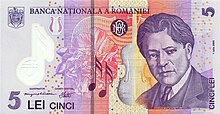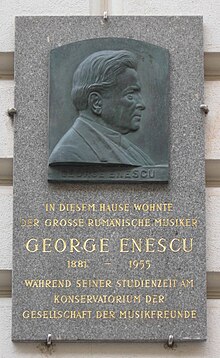George Enescu
George Enescu ( ; born August 19, 1881 in Liveni Vîrnav, today in Botoșani district ; † May 4, 1955 in Paris ) was a Romanian composer , violinist and conductor .
Life
Enescu already played the violin when he was four, composing when he was five, and one of his first teachers was the composer Eduard Caudella . From 1888 to 1894 he studied in Vienna , among others with Josef Hellmesberger junior , Ludwig Ernst and Robert Fuchs . In 1889 he made his public debut as a violinist. From 1895 to 1899 he also studied composition at the Paris Conservatory with André Gedalge , Jules Massenet and Gabriel Fauré ; his classmates included Maurice Ravel , Florent Schmitt and Charles Koechlin . In 1898 his Opus 1, the Poème Roumain , was heard in the Concerts Colonne ; in the same year he began conducting in Bucharest .
In 1902 Enescu founded a piano trio with Louis Fournier and Alfredo Casella , and in 1904 the Enescu Quartet. Parallel to his activities in Paris, however, he also worked in his home country, where he owned a house in Sinaia . In 1912 he initiated the Enescu Prize for Composition in Bucharest and in 1914 directed the first complete performance of Beethoven's 9th Symphony in Romania. In 1917 he founded the George Enescu Symphony Orchestra in Iași and finally the Society of Romanian Composers. In 1921 he opened the Opera Națională Bucureşti with his Lohengrin conducting and was accepted into the Romanian Academy in 1932 through his musicological studies . In 1937 Enescu married the great love of his life, Maria Cantacuzino (1878-1969), called Maruca (born Tescanu Rosetti ). The splendid Art Nouveau palace of the politician Gheorghe Grigore Cantacuzino in Bucharest's Calea Victoriei thus became the home (and now a museum) of Enescu. After a concert tour to the United States in the fall of 1946, Enescu did not return to Romania in protest against the communist government. He is buried in the Père Lachaise cemetery in Paris .
meaning

As a teacher he worked not only in France ( Conservatoire de Paris ) and Romania, but also in Siena , at the Mannes College of Music in New York and other American schools and universities; his students include Christian Ferras , Ivri Gitlis , Arthur Grumiaux , Leroy Anderson and Yehudi Menuhin .
These varied activities as a violinist, conductor, teacher, musicologist and organizer left Enescu little time to compose. His catalog of works is straightforward, and the individual works sometimes have a long creation time. His most important work, the opera Oedipe , was written between 1921 and 1931; some pieces, such as his second string quartet and the vocal symphonic poem Vox maris , are available in several versions, and several compositions, such as the 4th and 5th symphonies , remained unfinished (and were completed by Pascal Bentoiu in 2004 and 2005, respectively ). The counting of the opus numbers is also misleading; Enescu used to group groups of works under one number, even if there were decades between their creation.
Enescu's compositional style is difficult to pin down; he fluctuates between a monumental romanticism based on Richard Wagner in the first symphony (1903), French influences in the Sept chansons de Clément Marot (1908), neo-baroque tendencies in the second orchestral suite (1915) and a very individual modern expression as in many chamber music works, the opera Oedipe and the Chamber Symphony (1954), his last work. But Enescu is only known to the general public for his pieces inspired by Romanian folk music : the third violin sonata dans le caractère populaire roumain (1926), the third orchestral suite villageoise (1938), but above all with the two Romanian rhapsodies op.11 (1901 ), the popularity of which became unpleasant even to its creator. Even today they obstruct the view of the multifaceted oeuvre of the most important Romanian composer.
Works
Operas
- Oedipe . Lyric Tragedy op. 23 (1921–31; WP 1936)
Symphonies
- 4 early symphonies (D minor, 1894, F major, 1895, F major, 1896, E flat major, 1898)
- Symphony No. 1 in E flat major op.13 (1905)
- Symphony No. 2 in A major, Op. 17 (1912-14)
- Symphony No. 3 in C major op. 21 for piano, choir and orchestra (1916–18, rev. 1921)
- Symphony No. 4 in E minor (1934; unfinished, performance version prepared by Pascal Bentoiu)
- Symphony No. 5 in D major for tenor, female choir and orchestra (1941; unfinished, performance version prepared by Pascal Bentoiu)
Further orchestral works
- 3 overtures (1891–94)
- Tragic Overture (1895)
- Triumphant Overture (1896)
- Violin Concerto in A minor (1896)
- Fantasy for piano and orchestra (1896)
- Piano Concerto (1897; unfinished)
- Suite roumaine No. 1 (1896; unfinished)
- Suite roumaine No. 2 (1897)
- Poème roumain op.1 with male choir (1897)
- Symphonie concertante in B minor for violoncello and orchestra op.8 (1901)
- Suite No. 1 in C major op.9 (1903)
- 2 Rhapsodies roumaines op.11 (1901)
- 2 Intermezzi for strings op.12 (1902/03)
- Suite châtelaine (1911; fragment)
- Suite No. 2 in C major, op.20 (1915)
- Suite No. 3 villageoise in D major, op.27 (1937/38)
- Concert overture sur des thèmes dans le caractère populaire roumain A major op.32 (1948)
Chamber music
- Piano quintet (1895)
- Piano Trio (1897)
- Violin Sonata No. 1 in D major, Op. 2 (1897)
- Cello Sonata No. 1 in F minor, Op. 26 No. 1 (1898)
- Aubade for string trio (1899)
- Violin Sonata No. 2 in F minor, Op. 6 (1899)
- Andante religioso for 2 cellos and organ (1900)
- String Octet in C major op.7 (1900)
- Allegro de concert for harp (1904)
- Wind Decet in D major op.14 (1906)
- Concert piece for viola and piano (1906)
- Piano Quartet No. 1 in D major op.16 (1909)
- Piano trio in A minor (1916)
- String Quartet No. 1 in E flat major, Op. 22 No. 1 (1916-20)
- Violin Sonata No. 3 in A minor dans le caractère populaire roumain op.25 (1926)
- Cello Sonata No. 2 in C major op.26 No. 2 (1935)
- Impressions d'enfance for violin and piano op.28 (1940)
- Piano Quintet in A minor, Op. 29 (1940)
- Piano Quartet No. 2 in D minor, Op. 30 (1943/44)
- String Quartet No. 2 in G major, Op. 22 No. 2 (1950–53)
- Chamber Symphony in E major for 12 instruments op.33 (1954)
- Legend for trumpet and piano
Piano music
- Scherzo (1896)
- Piano suite No. 1 in G minor dans le style ancien op.3 (1897)
- Variations for 2 piano op.5 (1898)
- Piano Suite No. 2 in D major op.10 (1901–03)
- Prelude and Fugue (1903)
- Nocturne (1907)
- Piano suite No. 3 Pièces impromptues op.18 (1913–16)
- Pièce sur le nom de Fauré (1922)
- Piano Sonata No. 1 in F sharp minor, Op. 24 No. 1 (1924)
- Piano Sonata (No. 2) in D major, Op. 24 No. 3 (1933–35) (The Sonata, Op. 24 No. 2 was never written down.)
Choral works
- L'aurore for soprano, female choir and orchestra (1897/98)
- Vox maris . Symphonic poem for soprano, tenor, choir and orchestra op. 31 (1929–51)
- Liniște (Silence) (1946)
Songs
- Trois mélodies op.4 (1898)
- Sept chansons de Clément Marot op.15 (1908)
- 3 melodii op.19 (1915/16)
- about 25 other songs
literature
Until the Ceausescu regime was overthrown in 1990, Enescu research was almost entirely in Romanian hands. That is, everything that was published about Enescu in the musicological field appeared in Romanian. There were few researchers with outside access to the sources.
- Noel Malcolm (Author), Yehudi Menuhin (Editor): George Enescu: His Life and Music Toccata Press, 1999, ISBN 978-0-9076-8933-1
- Alain Cophignon, Georges Enesco (= Bibliothèque des grands compositeurs ), Librairie Arthème Fayard, Paris 2006, ISBN 978-2-213-62321-4
- Titu I. Băjenescu: Love is a serious and final thing: the life of the musician George Enescu . Henschel, Leipzig 2006, ISBN 978-3-8948-7569-5
- Dieter Nowka: George Enescu and the development of Romanian music . Pro-Universitate-Verlag, Sinzheim 1998, ISBN 3-932490-33-9 (Habilitation University Halle 1984, 114, [84] pages, illustrations, notes, 21 cm).
- Maria Zlateva Zlateva: Romanian Folkloric Influences on George Enescu's Artstic and Musical Development as Exemplified by His Third Violin Sonata. (Online dissertation University of Texas, Austin 2003, 97 pages full text online PDF, free of charge, 97 pages, 2.5 MB, English).
Web links
- Literature by and about George Enescu in the catalog of the German National Library
- International Enescu Society
- The Enescu Society in London ( Memento of July 14, 2007 in the Internet Archive )
- Muzeul Naţional George Enescu Museum (English)
- Georges Eenesco / George Enescu Profile at The Remington Site (English)
- George Enescu: biography, articles, concert announcements
- Sheet music and audio files by George Enescu in the International Music Score Library Project
- Sheet music in the public domain by George Enescu in the Choral Public Domain Library - ChoralWiki (English)
- Romanian Rhapsody No. 1 (youtube)
- Christoph Schlüren: Portrait of George Enescu. Dor and the ordering spirit ( memento of July 14, 2003 in the Internet Archive ) at: musikmph.de 1/98
- The Romanian pianist Eduard Stan on his current concert tour with the chamber music of George Enescu
| personal data | |
|---|---|
| SURNAME | Enescu, George |
| ALTERNATIVE NAMES | Enesco, Georges |
| BRIEF DESCRIPTION | Romanian composer, violinist and conductor |
| DATE OF BIRTH | August 19, 1881 |
| PLACE OF BIRTH | Liveni Vîrnav (today: George Enescu), Botoșani County |
| DATE OF DEATH | May 4th 1955 |
| Place of death | Paris |




